- New Sailboats
- Sailboats 21-30ft
- Sailboats 31-35ft
- Sailboats 36-40ft
- Sailboats Over 40ft
- Sailboats Under 21feet
- used_sailboats
- Apps and Computer Programs
- Communications
- Fishfinders
- Handheld Electronics
- Plotters MFDS Rradar
- Wind, Speed & Depth Instruments
- Anchoring Mooring
- Running Rigging
- Sails Canvas
- Standing Rigging
- Diesel Engines
- Off Grid Energy
- Cleaning Waxing
- DIY Projects
- Repair, Tools & Materials
- Spare Parts
- Tools & Gadgets
- Cabin Comfort
- Ventilation
- Footwear Apparel
- Foul Weather Gear
- Mailport & PS Advisor
- Inside Practical Sailor Blog
- Activate My Web Access
- Reset Password
- Customer Service

- Free Newsletter


Catalina 270 vs. The Beneteau First 265 Used Boat Match-Up

Ericson 41 Used Boat Review

Mason 33 Used Boat Review

Beneteau 311, Catalina 310 and Hunter 326 Used Boat Comparison

Tips From A First “Sail” on the ICW

Tillerpilot Tips and Safety Cautions

Best Crimpers and Strippers for Fixing Marine Electrical Connectors

Thinking Through a Solar Power Installation

Polyester vs. Nylon Rode

Getting the Most Out of Older Sails

How (Not) to Tie Your Boat to a Dock

Stopping Mainsheet Twist

Fuel Lift Pump: Easy DIY Diesel Fuel System Diagnostic and Repair

Ensuring Safe Shorepower

Sinking? Check Your Stuffing Box

The Rain Catcher’s Guide

What Do You Do With Old Fiberglass Boats?

Boat Repairs for the Technically Illiterate

Boat Maintenance for the Technically Illiterate: Part 1

Whats the Best Way to Restore Clear Plastic Windows?

Giving Bugs the Big Goodbye

Galley Gadgets for the Cruising Sailor

Those Extras you Don’t Need But Love to Have

What’s the Best Sunscreen?

UV Clothing: Is It Worth the Hype?

Preparing Yourself for Solo Sailing

How to Select Crew for a Passage or Delivery

R. Tucker Thompson Tall Ship Youth Voyage

On Watch: This 60-Year-Old Hinckley Pilot 35 is Also a Working…

On Watch: America’s Cup

On Watch: All Eyes on Europe Sail Racing

Dear Readers
- Sailboat Reviews
A handsome shoal-draft keel/centerboarder well-suited to cruising the Keys or the Chesapeake.
In the late 1960s and early 1970s, the names Charley Morgan and Ted Irwin were practically synonymous with Florida boatbuilding. Charley Morgan was definitely one of the designers and builders that shaped the early and middle years of fiberglass sailboat building.
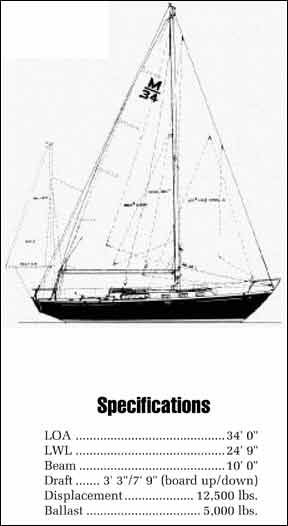
Morgan designs from that period run the gamut from cruising houseboats—the Out Island series—to the 12 meter sloop Heritage, the 1970 America’s Cup defense candidate that Morgan designed, built, and skippered.
But before Heritage , before the Out Island series, Charley Morgan designed cruiser/racers to the CCA rule. His successful one-off boats were typified by Paper Tiger , Sabre , and Maredea . Early Morgan designed production boats included the Columbia 40 and the Columbia 31.
In 1962, Morgan Yacht went into business to build the 28′ Tiger Cub. In 1965, the company really got rolling, building the Morgan 26, the 36, and the 42. In 1966 the Morgan 34 was added to the line. It stayed in production until the 1972 model year, when it was phased out in preference to the Morgan 35, a slightly larger, faster boat which fit a little better into the new IOR racing rule.
The Morgan 34 is a typical late CCA-rule centerboarder. Charley Morgan specialized in this type of boat, which was favored under the rating rule and well-adapted to life in the shoal waters of the Florida coast and the Bahamas.
By today’s standards, the Morgan 34 is a small boat, comparable in accommodations to a lot of 30-footers. When the boat was designed, she was as big as most other boats of her overall length.
In profile, the boat has a sweeping, moderately concave sheer. The ends of the boat are beautifully balanced: the bow profile is a slight convex curve, the overhanging counter aft is slightly concave. Esthetically, hull shapes of this period from the best designers are still hard to beat.
Sailing Performance
With a typical PHRF rating of 189, the Morgan 34 is not as fast as some of the more competitive cruiser/racers of the same vintage, such as the Tartan 34.
With just a little more sail area than the Tartan 34, the Morgan 34 is about 1,300 pounds heavier.
Most owners rate the boat as about the same speed both upwind and downwind as boats of similar size and type. At the same time, the boat’s performance is at least as good as a lot of more modern “pure” cruisers of the same length.
The rig is a simple, fairly low aspect ratio masthead sloop, using a slightly-tapered aluminum spar, stepped through to the keel.
Although there are double lower shrouds, the forward lowers are almost in line with the center of the mast, with the after lowers well behind the mast. On a lighter, more modern rig, this shroud arrangement would just about require a babystay, but on the stiff masts of the late 1960s, it would be essentially superfluous.
Early boats in the series have wooden spreaders. Unless well cared for, they can rot. For some reason, wooden spreaders on aluminum masts tend to get ignored more than the same spreaders on wooden masts.
The boom is a round aluminum extrusion equipped with roller reefing. Roller reefing is tedious, inefficient, and usually results in a poorly-shaped sail. If we were to buy a Morgan 34 for cruising, the first thing we’d do would be to buy a modern boom equipped with internal slab reefing.
Shroud chainplates are located right at the edge of the deck, so inboard genoa tracks would just about be a waste of time. The spreaders are short enough that you can sheet the genoa just inside the lifelines when hard on the wind.
Just about every piece of sailhandling equipment you’d normally expect on a cruiser/racer was an option on this boat. You may find extremely long genoa tracks—some boats originally carried 170% genoas, which were lightly penalized under the CCA rule—or you may find very short genoa tracks. Likewise, turning blocks, spinnaker gear, and internal halyards were all options.
The original jib sheet winches were Merriman or South Coast #5s. Compared to modern winches, they are slow and lack power. For anything other than casual daysailing, you’ll want to upgrade to modern two-speed self-tailing winches for the genoa.
At the aft end of the cockpit, there is an old-fashioned flat mainsheet traveler track. Although this isn’t a bad arrangement for a cruising boat, it would be tempting, while replacing the boom, to install a modern recirculating ball traveler. You could then keep the boat on her feet a little better close reaching in a breeze by simply easing the traveler car to leeward without slacking the mainsheet.
With the standard tiller, the mainsheet location is a bit of a problem, since the helmsman sits almost at the forward end of the cockpit. This is fine for racing, when the helmsman does nothing but steer, but it is awkward for shorthanded cruising.
Like a lot of boats with low aspect mainsails, the Morgan 34 tends to develop weather helm quite quickly as the breeze builds. Despite a 40% ballast/displacement ratio, the boat is not particularly stiff. She is narrow, and the shoal draft keeps the vertical center of gravity quite high.
The boat is quite easy to balance under sail in moderate conditions, thanks to a narrow undistorted hull, a long keel with the rudder well aft, and a centerboard. Owners report that on wheel-steered boats, you can tighten down the brake and the boat will sail itself indefinitely upwind.
Standard engine in the Morgan 34 was the Atomic 4 or the Palmer M-60, both gasoline engines. Perkins 4- 107 and Westerbeke 4-107 engines were $2,000 options.
If you can buy a used boat cheaply enough and plan to keep it for a few years, it would be a natural candidate for installation of one of Universal’s new drop-in Atomic 4 diesel replacements. However, since a new diesel would cost about 25% of the total value of the boat, such an upgrade is not something to be taken lightly.
With the side-galley interior with quarterberths aft, engine access for minor service is reasonable through panels in the quarterberths.
Engine access is less straightforward with the aft galley arrangement, requiring removing the companionway steps just to get to the front end of the engine. Almost unanimously, owners in our survey state that the boat is next to impossible to back down under power in any predictable direction. With a solid two-bladed prop in an aperture, reverse efficiency is minimal with no prop wash over the rudder.
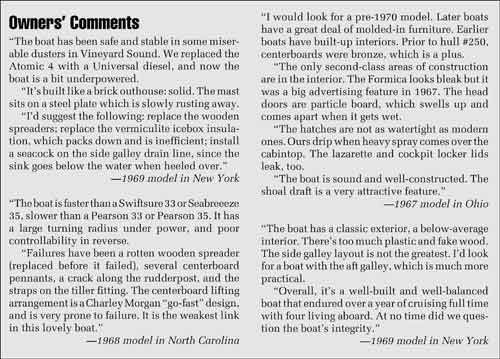
A 26-gallon Monel fuel tank was standard. Monel, an alloy of copper and nickel, is one of the few tank materials that serves equally well for gasoline, diesel oil, or water. It is prohibitively expensive, and is therefore rarely used for tanks in modern production boats. You may also find a Morgan 34 with another, optional, 15-gallon fuel tank.
Construction
In the late 60s and early 70s, Morgans were of pretty average stock boat quality. Glasswork is heavy, solid, and unsophisticated.
The construction is a combination of good features, coupled with corners cut to keep the price down.
Through hull fittings are recessed flush to the hull—good for light air performance—yet gate valve shutoffs were standard. Believe it or not, you could buy bronze seacocks as options for about $5 to $25 each! That’s what we call cutting corners.
Lead ballast is installed inside the hull shell. The classic drawback to inside ballast is the vulnerability of the hull shell to damage in a grounding.
The cockpit is very large, larger than desirable for offshore sailing. In addition, there is a low sill between the cockpit and the main cabin, rather than a bridgedeck. You can block off the bottom of the companionway by leaving the lower dropboard in place, but this is not as safe an arrangement as a bridgedeck. Cockpit scuppers are smaller than we would want for offshore sailing.
Molded fiberglass hatches are in most cases more watertight than badly designed or maintained wooden hatches, but they are almost never as good as a modern metal-framed hatch. They’re simply too flexible. When the seals get old, you tend to dog the hatch tighter and tighter, further compressing the seals and putting uneven pressure on the hatch cover. The result is almost always leaking. Leaking hatches may seem like a small problem, but they are like a splinter in your finger: the pain and nuisance are all out of proportion to the item inflicting the injury.
Like many centerboards, the Morgan 34’s can be a problem. The original board was a bronze plate weighing about 250 pounds. When fully extended, the bronze board is heavy enough to add slightly to the boat’s stability. Later boats have an airfoil fiberglass board of almost neutral bouyancy. There’s a lot less wear and tear on the wire pennant with the glass board.
You may find a Morgan 34 that has been owner-finished from a hull or kit. Sailing Kit Kraft was a division of Morgan, and you could buy most of the Morgan designs in almost any stage of completion from the bare hull on up.
A kit-built boat can be a mixed blessing. If you find a boat that was finished by a skilled craftsman, it could be a better boat than a factory-assembled version. On the other hand, it could also be a disaster. Since the quality control of a kit boat is monitored only by the person building it, an extremely careful survey is required.
No matter how well executed it may be, an owner-completed kit boat rarely sells for more than a factory-finished version of the same boat. Most buyers would rather have a boat with a known pedigree, even if the pedigree is pretty average.
There’s a decent amount of exterior teak on this boat, including the cockpit coamings, toerail, grabrails on the cabin, drop boards, hatch trim, and cockpit sole. Check the bedding and fastening of the cockpit coamings carefully. If you want to varnish coamings that have been either oiled or neglected, it may be necessary to remove and rebed them.
Exterior appearance of older boats such as the Morgan 34 is greatly improved by varnishing the teak trim. It particularly spiffs up boats with the faded gelcoat that is almost inevitable after 20 years of use.
The standard Morgan 34 was a pretty basic boat. There were single lifelines, a single battery. There was no sea hood over the main hatch, and no electric bilge pump. Most boats left the factory with a fair number of options, but you may not find a lot of things that would be standard today.
In general, the construction and design of the Morgan 34 are suited to fairly serious coastal cruising. We would not consider the boat for offshore passagemaking without improving cockpit scuppers, companionway and hatch sealing, cockpit locker sealing, and bilge pumps.
The Morgan 34 dates from the heyday of woodgrained Formica interiors. Woodgrained mica bulkheads are even more lifeless than oiled teak bulkheads. However, mica makes a pretty decent painting base if it is thoroughly sanded so that all traces of gloss are removed. Freshly-painted white bulkheads with varnished trim would make a world of difference in the interior appearance of this boat.
The interior trim on a lot of Morgan 34s is walnut, which is a pretty drab wood, even when varnished. For an extra $400 or so you could get teak trim. Unvarnished teak and walnut are very similar in appearance, although walnut is usually a bit darker.
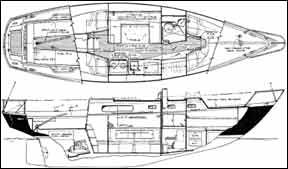
The forward cabin contains the normal V-berths, with a drawer and bin below on each side. A stainless steel water tank fills most of the space under the forward berths. The standard tank holds 30 gallons, but many boats have the optional 60-gallon tank.
A fiberglass hatch provides fair-weather ventilation for the forward cabin. A double-opening hatch was optional, as were opening ports in place of the standard fixed ports. Below the hatch, headroom is just over 6′.
The head compartment on the port side is quite cramped when the door is closed. However, it almost doubles in size if you close off the forward cabin with the dual-purpose head door, then close the sliding pocket door that separates the forward passageway from the main cabin.
Unfortunately, this pocket door is particle board, and it is likely to be a mushy mess, since any leaks around the mast drip right onto the door. “Waterproof” particle board found its way into a lot of boats in the 1960s and early 1970s. It shouldn’t have.
A shower installation was optional, and added about $800 to the base price of the boat for a pressure system, sump, pump and water heater. It is a desirable option if you plan on cruising.
You will find three different main cabin layouts. All were available as no-extra-cost options. In the most common layout, the galley occupies the starboard side of the main cabin, with a dinette opposite. This arrangment was fairly common in the late 1960s and early 1970s. You either love this galley/dinette arrangement or you hate it. Having spent a fair amount of time sailing offshore with a similar layout, we can say unequivocally that we hate it.
With the modern U-shaped galley, the cook can stand in one place and reach everything by simply turning around. With a linear galley, the cook has to take several steps to move from the icebox to the stove. This is fine when the boat is tied to the dock, but offshore it means that there’s no way the cook can wedge himself or herself in a single secure location while preparing meals.
A dinette also presents problems under way. Offshore, the most secure way to eat is to sit on the leeward settee, holding your plate in your lap. Unless there is a settee opposite the dinette, half the time you’ll be sitting on the uphill side of the boat while you’re trying to eat. This may be good for weight distribution while racing, but it’s not very secure. We’ve seen more than a few bowls of beef stew go flying from the windward to the leeward side of the main cabin when the boat took a knockdown.
Two different aft galley arrangements were options. In one, the dinette is retained, with a settee opposite. In the other, the dinette is replaced by a settee and pilot berth.
Choosing between these two is purely a matter of taste. The pilot berth layout gives three sea berths in the main cabin. On the other hand, the dinette table can be lowered to form a double berth.
The aft galley is larger than the side galley. To port, there is a gimballed stove, a large dry well, and outboard lockers. A sink, icebox, and other lockers are located on the starboard side.
Reduced access to the engine is the only disadvantage we see to the aft galley layout.
In common with a lot of boats of this period, the electrical panel is inadequate for the amount of goodies that are likely to have been installed in the boat over its life. The panel is also located in the worst possible place—directly under the companionway hatch.
With the aft galley, a good location for the electrical panel would be outboard of the sink tucked under the side deck. In all likelihood, you’re going to sacrifice that galley storage space to install navigation electronics anyway, since the top of the icebox is the only reasonable space to use as the chart table.
That’s right, there’s no nav station in this boat: we’re talking the late 1960s, when a boat with a radio, a depthsounder, and a knotmeter was heavily equipped with electronics.
There is reasonable storage space throughout the boat. Space under the settees is not taken up by tankage.
Headroom is 6′ 3″ on centerline throughout the main cabin, falling off to about 6′ at the outboard edge of the cabin trunk. All the berths are at least 6′ 6″ long, and they are proportioned for normal-sized human beings.
Decor in the main cabin is decidedly drab, between woodgrain laminate bulkheads and a sterile white fiberglass overhead liner. The original upholstery was vinyl, completing the low-maintenance theme. Paint, varnish, and nice fabric cushions would make a Cinderella of an interior that is reasonably roomy, laid out well, and uncluttered.
Ventilation in the main cabin isn’t great. There’s no overhead ventilation hatch, although there’s room to install one. Once again, the stock two small fixed ports may have been replaced with optional opening ports—a plus, but a small one.
A single long oval fixed port on either side of the main cabin gives the boat a very dated look. It would be tempting to remove the aluminum-framed port and replace it with a differently-shaped smoked polycarbonate window mounted on the outside of the cabin trunk and bolted through. We’d make a number of different patterns out of black construction paper and overlay them on the outside until we found a pleasing shape. You’d be surprised at how this would dress up appearance.
Conclusions
The Morgan 34 is similar in design and concept to the more-popular Tartan 34, which dates from the same period. By comparison, the Tartan 34 is lighter, faster, and has less wetted surface, since it lacks the Morgan’s full keel. As a rule, we prefer the Tartan 34’s construction details, although Morgan owners report somewhat less gelcoat crazing and deck delamination.
In 1970, the Morgan 34 and the Tartan 34 were almost identical in price. Today, however, the same Tartan 34 will cost about 20% more than the Morgan 34. Part of that difference in price stems from the fact that the Tartan 34 is less dated in appearance, design, and finishing detail.
If you want a keel/centerboarder for cruising in shoal waters such as the Bahamas, the Gulf of Mexico, or the Chesapeake, but don’t want to spend the money for the Tartan 34, a Morgan 34 is a good alternative. With effort and money, you can upgrade the Morgan 34 quite a bit. As always, however, you should compare the dollars and amount of time invested before getting involved with a boat that dates from a period when the aesthetics of hull design were light years ahead of the nitty gritty of detailing and interior design.
RELATED ARTICLES MORE FROM AUTHOR
There is a Morgan 34 for sale at a good price in good condition, but it needs a mast. How much and where can I get a reasonable mast? Roger
I may know. Plus I have a 34 Morgan, I may sell at a very reasonable price, with dockage.
Great report on this boat! I bought this boat about a year ago without seeing it in the water I have no idea on how it performs. This write up gives me some points of interest. I am %80 through a refit and have updated a lot mentioned in this article. I can’t complain as I got the boat with a Westerbeke in it for well less than 10k. The plan is to use it to curcumnavigate an island in the North Atlantic starting in 2023. Watch “FRILL” on youtube coming soon!
Hello sailors! I own a Morgan 34 and am trying to find where the holding tank is and the seacock associated with it. Can anyone help?
LEAVE A REPLY Cancel reply
Log in to leave a comment
Latest Videos
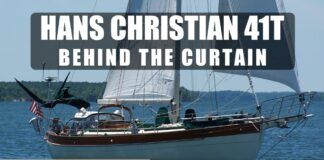
Hans Christian 41T – Boat Review

Seven dead after superyacht sinks off Sicily. Was the crew at...


What’s the Best Sailboats for Beginners?

Why Does A Sailboat Keel Fall Off?
Latest sailboat review.
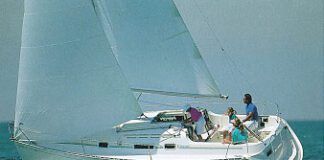
- Privacy Policy
- Do Not Sell My Personal Information
- Online Account Activation
- Privacy Manager

Charley Morgan’s early yachts look great and sail even better
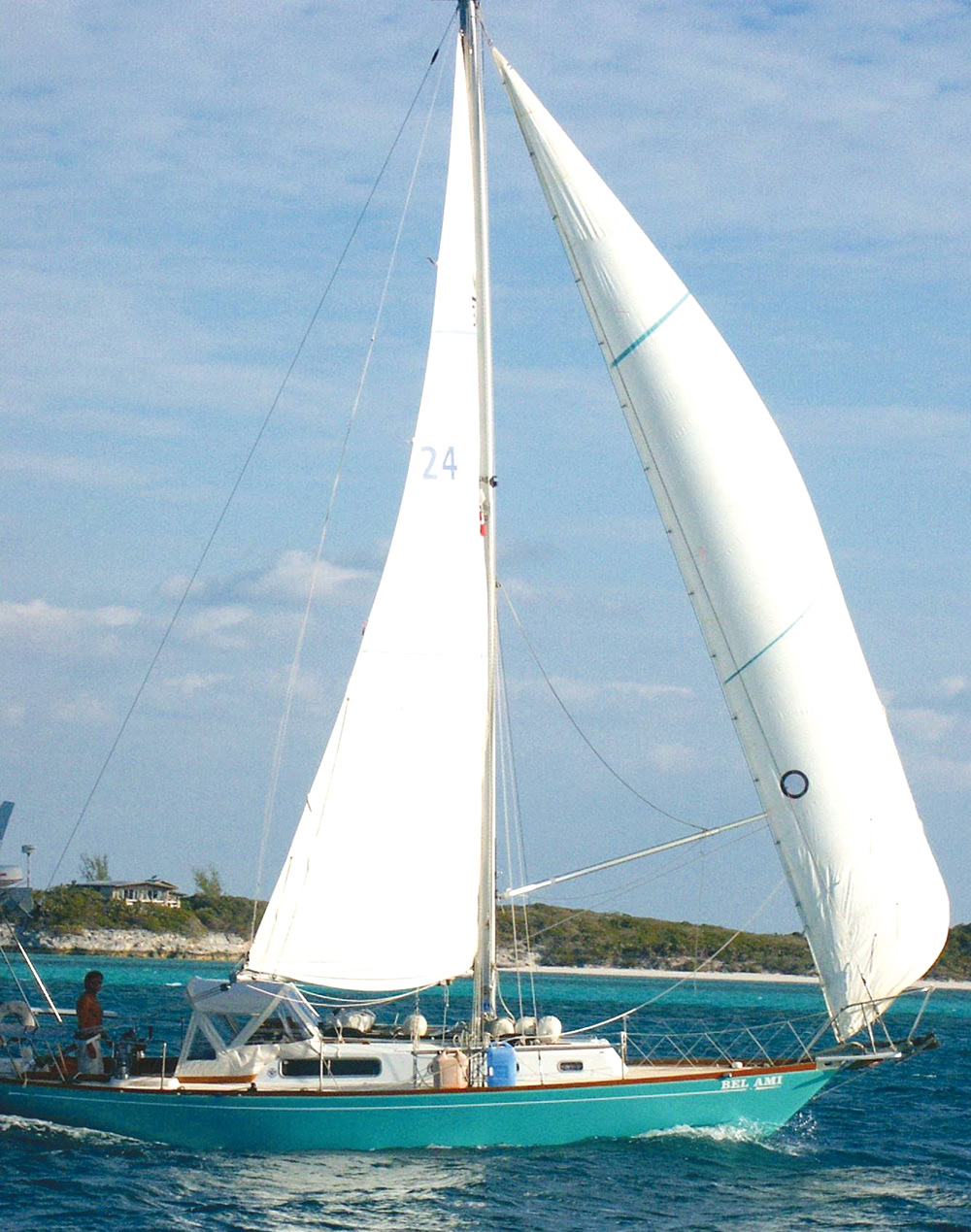
With Paper Tiger ’s victories still fresh in the minds of sailing enthusiasts, he founded Morgan Yachts in 1963 in St. Petersburg, Florida, and in 1965 launched the Morgan 34, a handsome masthead sloop.
“It was Labor Day when we launched the first one,” he said from his home in Treasure Island, Florida, “Although 6 feet shorter than Paper Tiger , the M-34 had a similar amidships section, powerful yet comfortable in a seaway. And the centerboard can take you anywhere.”
The M-34 was designed as a racer-cruiser to accommodate what were then the Cruising Club of America rules. It was priced at $14,995 and offered three interior layout options. The boat’s popularity among the racer-cruiser crowd was almost immediate, perhaps reflected by the fact that in 1965 the company grossed $1.7 million in sales.
Morgan Yachts thrived and was eventually merged with the international conglomerate Beatrice Foods in 1968. Morgan stayed on to design the wildly popular, shallow-draft Morgan Out Island 41, a roomy, easy-to-sail yacht with a center cockpit that soon became the darling of the charter fleet industry. At about the same time, Morgan designed, built and skippered the 12-Meter Heritage , for the 1970 America’s Cup defense candidate.
When Morgan retired in 1972, the company was offering 17 models. It was the last year of production for the M-34, which was replaced by the faster Morgan 35. Beatrice Foods sold the company to Catalina Yachts in the 1990s, after which the Morgan name was no longer used. By then the company had relocated to Largo, Florida.
While continuing to design boats, Morgan frequently sailed his beloved M-34 Checkmate , which carried a 180% genoa as was standard in the 1960s under the CCA handicapping rule.
First impressions
Traditionalists are likely to fall in love with the M-34 at first glance, with its lovely sheer, graceful overhangs and many teak accents, from cockpit sole and coamings to toerails and cabintop grabrails. The relatively large cockpit is inviting and the narrow beam adds to the sense of overall sleekness.
Construction
The M-34 is part of the classic-plastic era known for its heavy-duty fiberglass construction and encapsulated lead ballast. The hull is solid fiberglass, the deck a fiberglass sandwich with a balsa core. The hull and deck are attached with mechanical fittings. An adhesive was also applied, but this was in the days before silicone so it tended to dry out. Deck fittings and other hardware are bronze or stainless steel. The mast is stepped onto the keel for strength. The centerboard, at least on earlier models, is heavy bronze.
More than 400 M-34s were constructed. According to Morgan, the company began offering its Sailing Kit Kraft program that allowed owners to finish the boat after the hull and deck were delivered. It’s unclear how many buyers chose this option. As a result, some of the boats on the market may be well built or reflect the work of an amateur.
What to look for
The Morgan 34 is strongly built, but the oldest have been around for nearly a half century. That means stress cracks are likely in the gelcoat, the deck and around fittings, especially stanchions, cleats and rails. Discoloration of fiberglass on the decks and topsides could indicate water absorption. The electrical system, if original, may consist of a tired fuse box and wiring in need of replacement. The centerboard, as it is on any boat, should be a point of concern. On the M-34, early models have a bronze centerboard weighing 250 pounds, which can put plenty of stress on the cables and sheaves used to raise and lower it. The sheaves can easily rust. Later centerboards were constructed of fiberglass.
The steering system should also be inspected although it isn’t easy to access. The mast step is an area known to need upgrading because it sits in saltwater trapped in the bilge. The metal step plate can rust out and should be replaced with a beefy synthetic one to reduce electrolysis. All chainplates should be inspected for leaks and cracks.
Most seacocks are bronze with gate valves. With a little TLC and elbow grease, they typically can be brought back to life.
The molded fiberglass hatches were new in their day and better than their wooden predecessors, but today’s metal-framed hatches are far superior.
The M-34 was a masthead sloop with double lower shrouds, and the spreaders on the early boats were wood. The roller reefing on the boom can prove cumbersome and difficult to operate. The chainplates are securely bolted to the edge of the deck. Original M-34s will likely have Merriman or South Coast No. 5 winches.
The flat mainsheet traveler might require upgrading to a more modern traveler on the coachroof. The cockpit has been described as overly roomy for offshore sailing, especially if a wave breaks over the deck. Some owners suggest the cockpit might be better with a bridgedeck instead of a low sill in order to keep seawater from entering the cabin. Owners also have complained the cockpit scuppers are small and do not drain with enough speed and efficiency. Some boats have tillers, others are outfitted with wheels.
What you see down below may depend on when the boat was built and who did the carpentry, plumbing and wiring. The most common layout features the galley to starboard with the dinette opposite. Some M-34s had an aft galley. The interior bulkheads were made of walnut or teak, the latter more expensive and richer in appearance. There’s plenty of natural light entering from the one large portal on each side of the saloon, supplemented by three smaller portals on each side, which provide adequate ventilation.
The boat is narrow compared to today’s 34-footers, and this impacts the amount of living space below deck. However, there is more than six feet of headroom in the saloon. The head, on the port side, is small and, depending on finish, may have a shower. Berths include the settee, pipe berths and V-berth, all depending on the model.
An M-34 could be ordered with a standard 30-horsepower Universal Atomic 4 gasoline engine or a Palmer M-60 gasoline engine. Some owners chose to pay an additional $2,000 and bought a Perkins 4-07 diesel engine or a Westerbeke 4-107. Today the diesels would command a higher price than the gasoline engines.
Owners advise installing a three-cylinder when upgrading because the boat weighs more than 6 tons. M-34 owner Jay Schryver of Rhode Island replaced the original Atomic 4 gasoline engine with a 30-horsepower Yanmar diesel in 1990 and it continues to easily power his yacht, Yellow Bird .
The boat has a 26-gallon Monel fuel tank, made from a combination of copper and nickel.
Despite its rugged construction, it is known as a tender boat at least until it starts to heel when it tracks nicely. It can also be subject to weather helm. Without a traveler running the width of the cockpit, the relatively large mainsail can be difficult to adjust. Without a full keel, the M-34 doesn’t sail efficiently to windward, which is why Schryver, who has been sailing Yellow Bird for decades, appreciates the centerboard.
“With the centerboard, she goes fast off the wind,” he said. “And she has a well-balanced helm.”
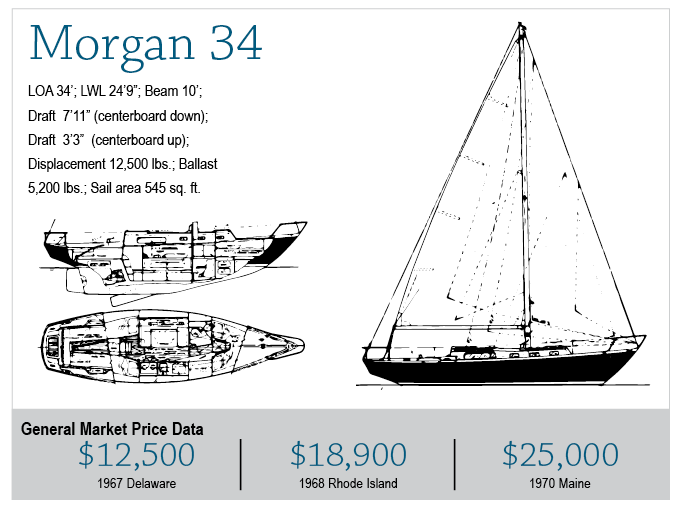
The Morgan 34 is a handsome, versatile, strongly built cruiser with excellent sailing capabilities and plenty of room below for a cruising couple.
SAILING's Value Guide
(5-star rating system)
PRICE: The price of a used Morgan 34 typically ranges from just over $12,000 to more than $25,000, depending on overall condition and upgrades. ★★★☆☆
DESIGN QUALITY: With a winning racing yacht pedigree behind him, Charles Morgan Jr. designed the Morgan 34 sloop as a traditional racer-cruiser. The centerboard model allows for thin-water sailing. ★★★☆☆
CONSTRUCTION QUALITY: The Morgan 34 was strongly built with a solid fiberglass hull and a fiberglass and balsa-core deck. The aluminum mast was stepped directly to the keel for strength. The boat carried a 250-pound bronze centerboard, but it was later replaced with a lighter, fiberglass centerboard. ★★★★☆
USER-FRIENDLINESS: The centerboard requires maintenance to ensure it operates properly. The boat’s original winches are undersized and not self-tailing, and the roller-reefing on the boom can be inefficient and cumbersome to use. ★★★☆☆
SAFETY: The encapsulated lead coupled with the centerboard’s weight and function were designed to keep the boat upright in a stiff breeze. The cockpit is considered somewhat large for offshore sailing and the scuppers too small. ★★★★☆
TYPICAL CONDITION : The Morgan 34 was in production for six years, from 1966 to 1972. Since the oldest yachts are 43 years old, the overall condition may vary widely. Condition may also depend on whether the boat was built by Morgan Yachts, or was a kit boat that allowed owners to finish the boat themselves. ★★☆☆☆
REFITTING: Like any older boat, finding parts can be a challenge. Many Morgan 34s on the used-boat market have undergone refitting that typically includes replacing the gasoline engine with a diesel, adding a boomvang and changing from end-boom to midboom sheeting. ★★★☆☆
SUPPORT: Morgan Yachts is no longer in business but support is available from online owner associations and from Morgan himself via his website www.charleymorgan.com . ★★☆☆☆
AVAILABILITY: In summer 2015, at least seven Morgan 34s were on the used boat market in the United States. ★★★☆☆
INVESTMENT AND RESALE: The boat has a strong resale value often based on the designer’s reputation, its sailing capabilities, and the beefy hull and standing rigging. ★★★★☆
Also in Used Boat Notebook
- Hunter Vision 32
- Hunter Passage 42
- Pearson Rhodes 41
- Santa Cruz 52
- Allied Princess 36
Also from David Liscio
- Chasing a dream
- The wide, wide world of multihulls
- Flares are expired. Now what?
- Saved from the scrap heap
- Pedal to the Medal

Boats for Sale
34' morgan 34 sloop.
Stock #133855 - Popular Morgan 34! 1967 Morgan 34 for sale St. Pete Florida Morgan is known for it long sailing history. This Morgan has seen a lot of sailing over the years. She now resides on the hard awaiting new ownership. Down below to starboard is a galley with newer countertops, plenty of storage for extended trips. She has room for 4 passengers and crew to sleep. Also has a nice enclosed head. This Morgan is powered by a Yanmar 3YM20 engine. The boat has a mainsail, 140 genoa, and a spinnaker. The engine has an estimated 150 hours. Several years back she was sanded down and her hull was repainted, as well as the bottom. The seller replaced a lot of hardware with stainless steel. They also installed a drive shaft, shaft log, dripless seal, and rudder log. We are looking for people all over the country who share our love for boats. If you have a passion for our product and like the idea of working from home, please visit WhereFreedomTakesYou [dot] com to learn more. Please submit any and ALL offers - your offer may be accepted! Submit your offer today! Reason for selling is no time to use. At Pop Yachts, we will always provide you with a TRUE representation of every vessel we market. We encourage all buyers to schedule a survey for an independent analysis. Any offer to purchase is ALWAYS subject to satisfactory survey results. You have questions? We have answers. Call us at (941) 538-7803 to discuss this boat. Selling your boat has never been easier. At Pop Yachts, we literally sell thousands of units every year all over the country. Call (855) 218-2805 and we'll get started selling your boat today. Take a look at ALL ***122 PICTURES*** of this vessel on our main website at POPYACHTS DOT COM. We appreciate that you took your time to look at our advertisement and we look forward to speaking with you!
- Specifications
- Description
Condition This popular model Morgan is currently sitting on the hard. She was hauled and underwent a refit, but has been sitting on the hard for several years now. She will need all her systems checked and freshened before use. Navigational Equipment - Depth Sounder - Masthead Light: - Navigation Lights - Running Lights - VHF Mechanical - Bilge Pump - Bottom Paint - Cutlass Bearing (New) - Dripless Shaft Seal (New) - Number Of Fuel Tanks (One) - Throttle/shift Electrical Systems - Battery Perko Switch - Cockpit Lighting - Courtesy Lights - Interior Lighting (Led) - Inverter - Shore Power - Tach - Fuse Panel Accommodations - Beds - Cabin Door - Cabin Fan - Cabin Lighting - Cabinets - Propane Tanks - Shower - Sink - Stove / Oven (Force 10) - Table - Toilet Manual Flush - V Berth - Dinette - Head Deck Gear - Anchor (2) - Anchor Chain - Anchor Locker - Anchor Rode - Cleats - Cooler (Yeti) - Cushions (Cockpit) - Dinghy (Hard Sailing) Safety Equipment - Fire Extinguisher - Life Jackets - Propane Storage Locker Sails - Genoa - Main Sail - Spinnaker - Covers - Sail - Roller Furling Jib Rigging - Backstay - Blocks - Boom - Chain Plates - Forestay - Furler - Mast - Rigging Hardware - Roller Furling System - Running Rigging - Sloop Rig - Spinnaker Pole - Standing Rigging - Winches
Connecting with Marinesource.com
Copyright 1992-2024 MarineSource Network, Inc. All Rights Reserved.

1967 Morgan 34 Technical Specs
General data about morgan 34.
| Brand | |
| Model | |
| Boat Type | |
| Category | |
| Year Of Production | |
| Condition (New/Used) | |
| Country | |
| Fuel (Gas/Diesel) | |
| Hull Material Used | |
| Length | |
| Selling Price | |
| Vat Status | |
Engine and Power Specs
| Engine manufacturer | |
| Engine Series | |
| Engine Location | |
| Engine Hours |
Dimensions And Wieght
| LOA (Length Overall) | |
| L.W.L(Length WaterLine) | |
| Dry Weight (Empty) | |
| Boat Maximum Draft | |
| Boat Keel Type | |
| Beam Width | |
| BC (Bridge Clearance) |
Detailed Specifications
| Numebr of Cabins | |
| Number of Seats | |
| Hull Type and Design | |
| Gas Tank Size | |
| Drinking Water Tank | |
| Berth (Mono/Single) |
Features And Equipments
Sailing features.
| Spinnaker |
| Roller furling jib |
| Main sail |
| Genoa |
| Covers - sail |
Safety Features
| Propane storage locker |
| Fire extinguisher |
Other Equipments
| Winches |
| Standing rigging |
| Spinnaker pole |
| Sloop rig |
| Running rigging |
| Running lights |
| Roller furling system |
| Rigging hardware |
| Navigation lights |
| Masthead light |
| Mast |
| Life jackets |
| Furler |
| Forestay |
| Depth sounder |
| Chain plates |
| Bottom paint |
| Boom |
| Blocks |
| Backstay |
Interior Specifications
| V berth |
| Toilet manual flush |
| Stove / oven |
| Sink |
| Shower |
| Head |
| Dinette |
| Cabinets |
| Cabin lighting |
| Cabin fan |
| Cabin door |
| Beds |
Engine And Mechanical Specs
| Throttle/shift |
| Number of fuel tanks |
| Dripless shaft seal |
| Cutlass bearing |
| Bilge pump |
| 21.0 hp |
Electronical And Electrical Info
| Vhf radio |
| Tach |
| Shore power |
| Inverter charger |
| Interior lighting |
| Fuse panel |
| Courtesy lights |
| Cockpit lighting |
| Battery perko switch |
Deck Hardware
| Table |
| Propane tanks |
| Dinghy |
| Cooler |
| Cleats |
| Anchor rode |
| Anchor locker |
| Anchor chain |
| Anchor |
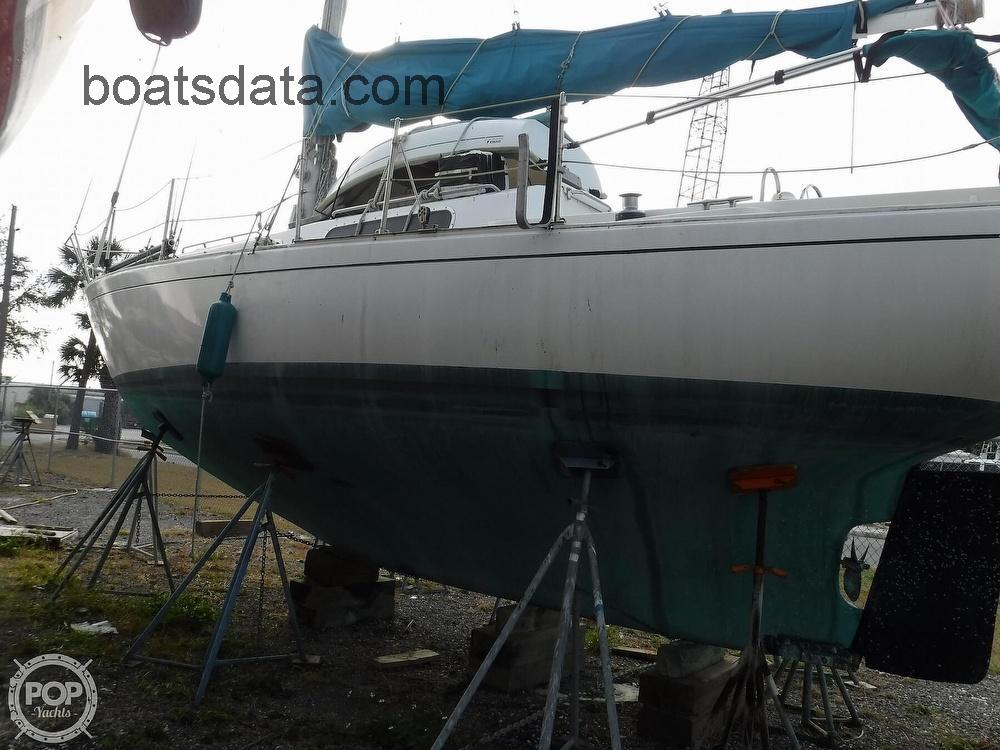
- Morgan provided us with the latest version of its 34 service repair manual
- Find All mechanical and electrical parts and accessories of Morgan 34 Sail here
Morgan 34 competitors
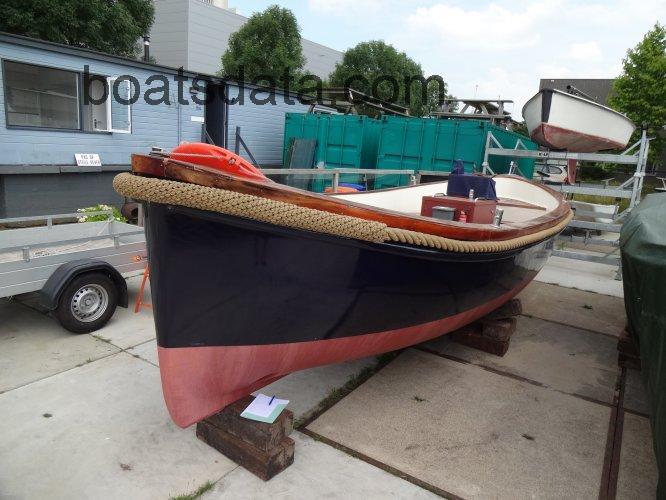
- Boats for Sale
Morgan 34 for sale
Receive new listings in your email
Manufacturer
1 New and Used Morgan 34
Crystal River, Florida (United States of America)
OFFERED BY:
Popular Morgan 34! 1967 Morgan 34 for sale St. Pete Florida Morgan is known for it long sailing history. This Morgan has seen a lot of sailing over the years. Down below t...
* Price displayed is based on today's currency conversion rate of the listed sales price.








IMAGES
VIDEO
COMMENTS
Notes. The MORGAN 34 was the first real production yacht from Morgan Yachts and among the most successful. A few later versions had a separated rudder on skeg. Some later boats were sold as kits. Early boats had bronze centerboards. Later on this was changed to fiberglass. Charles Morgan owned his own MORGAN 34 for many years.
The Morgan 34 is a typical late CCA-rule centerboarder. Charley Morgan specialized in this type of boat, which was favored under the rating rule and well-adapted to life in the shoal waters of the Florida coast and the Bahamas. By today's standards, the Morgan 34 is a small boat, comparable in accommodations to a lot of 30-footers.
Popular Morgan 34! 1967 Morgan 34 for sale St. Pete Florida Morgan is known for it long sailing history. This Morgan has seen a lot of sailing over the years. ... Used Boat Review: Tartan 34. Steve Knauth. January 16, 2010. Boat Reviews. Hallberg-Rassy 31: Bob Perry Design Review . Bob Perry. June 5, 2002. Boat Reviews. J/133: Fingertip Control ...
Stock #133855 - Popular Morgan 34!1967 Morgan 34 for sale St. Pete FloridaMorgan is known for it long sailing history. This Morgan has seen a lot of sailing over the years. She now resides on the hard awaiting new ownership.Down below to starboard is a galley with newer countertops, plenty of …
32.4. 30-40: moderate bluewater cruising boat. This ratio assess how quickly and abruptly a boat's hull reacts to waves in a significant seaway, these being the elements of a boat's motion most likely to cause seasickness. Comfort ratio = D ÷ (.65 x (.7 LWL + .3 LOA) x Beam.
Morgan 34 preowned sailboats for sale by owner. Morgan 34 used sailboats for sale by owner.
The MORGAN 34 was the first real production yacht from Morgan Yachts and among the most successful. A few later versions had a separated rudder on skeg. Some later boats were sold as kits. Early boats had bronze centerboards. Later on this was changed to fiberglass.
An M-34 could be ordered with a standard 30-horsepower Universal Atomic 4 gasoline engine or a Palmer M-60 gasoline engine. Some owners chose to pay an additional $2,000 and bought a Perkins 4-07 diesel engine or a Westerbeke 4-107. Today the diesels would command a higher price than the gasoline engines.
Stock #133855 -. Popular Morgan 34! 1967 Morgan 34 for sale St. Pete Florida. Morgan is known for it long sailing history. This Morgan has seen a lot of sailing over the years. She now resides on the hard awaiting new ownership. Down below to starboard is a galley with newer countertops, plenty of storage for extended trips. She has room for 4 ...
1967 34' Moran Yachts Morgan 34 sailboat for sale in Cornucopia Wisconsin. Home. Register & Post. View All Sailboats ... 1967. 34' 10' 3.25' Wisconsin. $9,900. Description: Spent its entire life on Lake Superior 100% fresh water boat Single Owner! Its been in the family for over 50 years! ... This Moran Yachts Morgan 34 : Added 22-May-2018 ...
Popular Morgan 34! 1967 Morgan 34 for sale St. Pete Florida. Morgan is known for it long sailing history. This Morgan has seen a lot of sailing over the years. Down below to starboard is a galley with newer countertops, plenty of storage for extended trips. She has room for 4 passengers and crew to sleep.
Fiberglass. Length. 10.36 m / (34.00 ft) Selling Price. 26.500 (USD) Vat Status. Tax Not Applicable. Service repair manual. Morgan 34 Manual.
1967 34' 1967 Morgan 34 Racer and Cruiser Sailboat. See boat pictures, videos, and detailed specs. Advanced Search. Guides . ... 1967 Morgan 34 Racer and Cruiser Sailboat. Back to Results > Sail > Racers and Cruisers > 1967 34' Morgan 34 This listing is no longer active. 1 / 2. Sales Status Inactive;
33.99 ft. YEAR: 1967. LOCATION: Crystal River, Florida (United States of America) OFFERED BY: POP Sells. Popular Morgan 34! 1967 Morgan 34 for sale St. Pete Florida Morgan is known for it long sailing history. This Morgan has seen a lot of sailing over the years.
1967 34' morgan sailboat for sale in LAKE CHAMPLAIN Port Henry N Y New York
Locate Morgan boat dealers and find your boat at Boat Trader! Find Morgan 34 boats for sale near you, including boat prices, photos, and more. Locate Morgan boat dealers and find your boat at Boat Trader! ... 1967 Morgan 34. $40,000. Crystal River, FL 34429 | Pop. Request Info < 1 > Connect with Us. Download the BoatTrader app. Explore Boat Trader.
- Stock #133855 - Popular Morgan 34! 1967 Morgan 34 for sale St. Pete Florida Morgan is known for it long sailing history. This Morgan has seen a lot of sailing over the years. Down below to starboard is a galley with newer countertops, plenty of storage for extended trips. She has room for 4 passengers and crew to sleep. Also has a nice ...
Summary. Popular Morgan 34! 1967 Morgan 34 for sale ...
Go to Sailing Texas classifieds for current sailboats for sale. Morgan 34, 1967, Draft: 4ft. Beam: 10ft. Keel: Bronze Centerboard. Motor: Universal 35 Diesel. Batteries: 3 deep cycle batteries with battery charger. Tanks: 40 Monel Fuel tank and 60 Gallon water tank. Bathroom: Raritan Marine head with 13 gallon holding tank.
1967 Morgan 34. Salinas, CA, US. Listed Mar 17. Expired. $12,000 USD. Save. Share. Share. SMS. Email. Facebook. ... This boat has had a composting toilet added which means there are very few parts to break and it will last forever. ... The MORGAN 34 was the first real production yacht from Morgan Yachts and among the most successful. A few ...
This popular model 34 Morgan is available. The seller recently gave her a good going over and moved her from St. Pete, FL to Crystal River, FL. The boat was cleaned and systems checked. The seller is motivated to sell her! Stock #133855 Popular Morgan 34! 1967 Morgan 34 for sale St. Pete Florida Morgan is known for it long sailing history.
View a wide selection of Morgan 34 boats for sale in United States, ... Look for the exact boat you need with our new search! Search . Default Search. Boats PWCs. Boats for Sale View All. ... 1967. $40,000 Seller Pop 80. Contact. 941-265-2874.
1967 Morgan 34 Sailboat for sale in Crystal River, FL. $40,000.00. ... 1967 Morgan 34 for sale St. Pete Florida Morgan is known for it long sailing history. This Morgan has seen a lot of sailing over the years. Down below to starboard is a galley with newer countertops, plenty of storage for extended trips. She has room for 4 passengers and ...